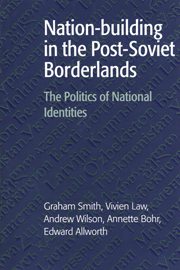Book contents
- Frontmatter
- Contents
- List of figures
- List of tables
- Preface
- The post-Soviet borderland states
- 1 Post-colonialism and borderland identities
- Part I Rediscovering national histories
- Part II Ethnopolitics and the construction of group boundaries
- 5 Nation re-building and political discourses of identity politics in the Baltic states
- 6 Redefining ethnic and linguistic boundaries in Ukraine: indigenes, settlers and Russophone Ukrainians
- 7 The Central Asian states as nationalising regimes
- Part III Language and nation-building
- Notes
- Index
6 - Redefining ethnic and linguistic boundaries in Ukraine: indigenes, settlers and Russophone Ukrainians
Published online by Cambridge University Press: 01 June 2011
- Frontmatter
- Contents
- List of figures
- List of tables
- Preface
- The post-Soviet borderland states
- 1 Post-colonialism and borderland identities
- Part I Rediscovering national histories
- Part II Ethnopolitics and the construction of group boundaries
- 5 Nation re-building and political discourses of identity politics in the Baltic states
- 6 Redefining ethnic and linguistic boundaries in Ukraine: indigenes, settlers and Russophone Ukrainians
- 7 The Central Asian states as nationalising regimes
- Part III Language and nation-building
- Notes
- Index
Summary
This chapter focuses on the politics of symbolic and cultural representation between (and within) three key groups of roughly equal size in Ukraine: Ukrainophone Ukrainians, Russophone Ukrainians and ethnic Russians. The threefold division is a simplification, but a useful one. It helps to explain why the titular nationality in Ukraine is divided within itself and has been unable to impose a nationalising agenda in the manner of Estonia and Latvia, or even some of the Central Asian states. It also helps to shift analysis away from ethnicity as the sole factor of importance in Ukrainian society and to focus attention on Russophone Ukrainians as a vital swing group. On the other hand, this chapter also seeks to deconstruct such categories by analysing the three groups as social constructs. It is not argued that they have immutable essences and boundaries.
According to Soviet census methodology (there has been no national census in Ukraine since independence in 1991; the first is scheduled for 1999), 64 per cent of the population of Ukraine in 1989 were classed as ‘native tongue’ Ukrainians, 9 per cent as ethnic Ukrainians who identified Russian as their ‘native tongue’ and 22 per cent were ‘Russian’ in terms of both ethnicity and language. The use of the term ‘native tongue’ in Soviet censuses (ridna mova in Ukrainian, rodnoi iazyk in Russian), however, was highly ambiguous. It tended to be interpreted in ancestral terms and therefore overlapped with ethnicity to an exaggerated extent.
- Type
- Chapter
- Information
- Nation-building in the Post-Soviet BorderlandsThe Politics of National Identities, pp. 119 - 138Publisher: Cambridge University PressPrint publication year: 1998
- 1
- Cited by

